
FAST technology advances wildland firefighting
By Blair Watson
Features Training Wildland"The basic concept of the FAST Bucket is simple and ingenious,” says Steve Matthews, one of the founders of Absolute Fire Solutions (AFS). FAST stands for Fire Attack Storm Tank, an innovative, highly efficient, aerial firefighting system that has been used by operators in Canada, the U.S., Australia, Mexico, Spain, Korea and Japan. AFS has its head office in Calgary and a manufacturing facility in Prince George, B.C.
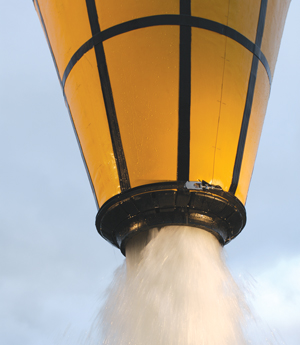
|
| The FAST Bucket’s design uses the weight of the water to create the hydraulic pressure required to actuate the release of each drop. |
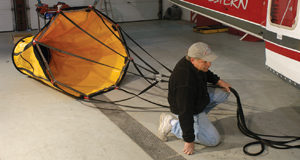 |
| Heavy-duty lanyards eliminate cables and tangling seen with conventional buckets and make FAST Bucket field deployment quick and easy. |
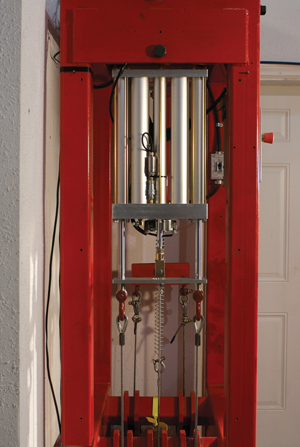 |
| Every FAST Bucket actuator is bench-tested – the bench simulates 1,000 full water drops in less than eight hours. Following the bench test, each FAST Bucket is tested in the water tank for 30 minutes before being certified serviceable. |
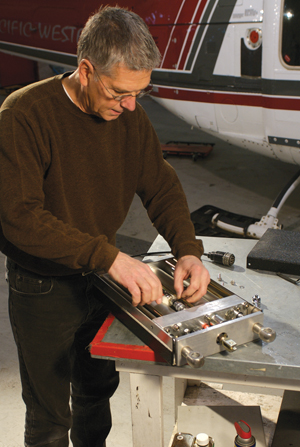 |
| Production Manager Gerry Bergeron assembles a FAST Bucket actuator for testing. |
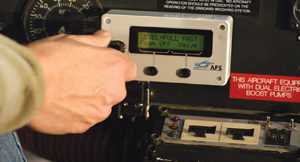 |
| The FAST Bucket’s cockpit controller allows the pilot to set the amount of water taken at each fill, a feature that substantially increases the total quantity carried and dropped for a given fuel load. |
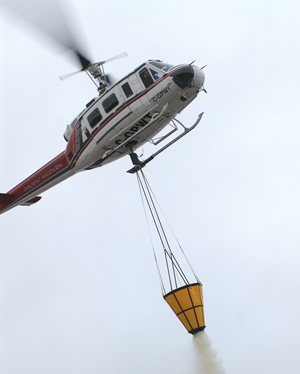 |
| For water drops, the pilot can select manual or automatic mode on the controller and do multiple drops in either mode. Photo courtesy Absolute Fire Solutions |
"The basic concept of the FAST Bucket is simple and ingenious,” says Steve Matthews, one of the founders of Absolute Fire Solutions (AFS). FAST stands for Fire Attack Storm Tank, an innovative, highly efficient, aerial firefighting system that has been used by operators in Canada, the U.S., Australia, Mexico, Spain, Korea and Japan. AFS has its head office in Calgary and a manufacturing facility in Prince George, B.C.
Helibuckets have been used to fight wildfires and other types of conflagrations for decades. Fresh water weighs 1,000 kilograms per cubic metre and seawater almost three per cent more. Helibuckets carry between 275 and 9,840 litres, depending on the make and model. With as much as 10,160 kilograms of water suspended beneath a helicopter, the pilot must ensure that the water in the helibucket does not exceed the aircraft’s payload capacity for a given altitude, temperature and fuel load.
A solution to match the weight of transported water to the helicopter’s payload capacity was devised more than 25 years ago – a heli-bucket cinch belt. However, to increase the volume of water as fuel is burned and the payload capacity increases, the pilot must land and adjust the cinch belt, a time-consuming activity rarely possible near fire zones. The FAST Bucket’s cockpit controller addresses this issue by allowing the pilot to pre-set the amount of water taken at each fill, a feature that substantially increases the total quantity carried and dropped for a given fuel load.
Another limitation of conventional heli-buckets is the lack of a multiple-drop capability. Once the pilot activates the release valve, all the water is discharged in one concentrated salvo, whether or not the entire amount is needed on a hot spot. To continue firefighting, the pilot has to fly back to the water source, refill the bucket and return to the fire. Water, time and fuel are wasted fighting low-intensity fires such as grass fires or during cleanup efforts where small hot spots remain. One of the features of the FAST Bucket is a multiple-drop capability; the pilot can do up to seven split drops using the controller and can also select fast drops or slow drops to vary drop concentration as required.
The FAST Bucket employs the weight of the water to create the hydraulic pressure required to actuate the release of each drop. The pressure is measured via a transducer, which creates the electrical power required by the cockpit controller. The weight of the water in the bucket creates a hydraulic force within an actuator – a manifold containing five cylinders – attached to the helicopter’s cargo hook. The hundreds or thousands of kilograms of water picked up in the FAST Bucket creates pressure as great as 1,000 psi within the cylinders. No matter how much water is carried, the FAST Bucket requires only 1.4 amps to release the load. A conventional bucket, with a powered hydraulic water release valve requiring up to 60 amps of power for actuation, fights against the weight of the water instead of using it for the water release/drop function.
Conventional hydraulic systems often require a hydraulic “pack” installed on the floor of the helicopter, with hydraulic lines extending down to the control head and the bucket valve, which adds weight and reduces the amount of water that can be transported to the fire. The FAST Bucket does not require a hydraulic pack or lines; the hydraulic fluid is used (circulated) within the actuator’s cylinders.
The centre cylinder contains a piston connected to a cable extending down the centre of the FAST Bucket to the water release flap. Typically, the actuator is six to 12 metres above the FAST Bucket’s top rim. The two outer cylinders each contain a piston, both of which are connected to the bucket shell via eight attachment points around its rim.
As the pilot increases altitude after filling the FAST Bucket, the combined weight pulls down on the two piston arms, creating pressure on the hydraulic fluid under each piston. The transducer measures the hydraulic pressure and converts it proportionately to voltage. The digital controller on the cockpit panel reads the voltage, and when the voltage pre-set by the pilot – via a rheostat on the controller – matches that created by the transducer/hydraulic pressure, a solenoid in the two outer cylinders opens and allows hydraulic fluid to flow into the centre cylinder.
How does the water release flap open? As the hydraulic fluid moves from the outer cylinders to the centre cylinder, the outer pistons drop, while the centre piston rises. Because of the two outer arms and centre cable, the bucket drops while the cable connected to the flap rises. These simultaneous and rapid actions result in the flap opening, with the duration being controlled by how long the solenoids remain open.
Control of the amount of water taken into the bucket is achieved by matching the voltage generated by the transducer with the setting of the controller rheostat. When this occurs on a bucket fill, a centre solenoid opens, releasing the hydraulic fluid from the centre cylinder and letting the flap close when the pre-set quantity has been reached. Thus, precise control of the amount of water lifted in the FAST Bucket is achieved. As the helicopter burns fuel and the payload capacity increases, the pilot simply rotates the rheostat – a knob – on the controller to increase the amount of water to be filled.
For water drops, the pilot can select manual or automatic mode on the controller and do multiple drops in either mode. For example, if the FAST Bucket contains 4,000 litres of water, the pilot can drop, say, 1,000 litres on the first fire spot and 600 litres on each of the next five spots (in manual mode). No other helicopter firefighting system in the world provides pilots with such water-drop precision and operational flexibility.
As mentioned, the control manifold contains five cylinders. The two inner cylinders are unpressurized accumulators containing springs that reset the outer pistons to the fully raised position when the bucket is empty. The accumulators govern the return flow of hydraulic fluid to the outer cylinders.
The predecessor to the FAST Bucket was a sling tank system developed in Australia. In the spring of 2005, Matthews and his partner Brett Cameron bought the technology, which has four pending patents. The following year, 10 beta versions were tested with helicopter operators in Canada and the United States.
In 2007, aviation equipment maker Simplex Manufacturing of Portland, Oregon, signed on as the worldwide distributor and production began in earnest with its support. Sales were limited to North America last year and expanded globally this year.
Matthews says operator response to the Fire Attack Storm Tank system has been excellent, with more than 100 units being sold to date. The smallest FAST Bucket can carry 160 US gallons/606 litres; the largest, 1,200 US gallons/4,542 litres. Cost ranges from about $7,000 to $30,000.
With AFS’s advanced technological capabilities and Simplex’s worldwide marketing and distribution network, the FAST Bucket has emerged as the main competitor to the industry king, SEI Industries’ Bambi Bucket. Advantages of the former are several, including up to 40 per cent more water load per fuel cycle, no manual cinching and fast and slow water release. Another player in the helibucket market is A-Flex Technology’s Monsoon Bucket, which, unlike the FAST Bucket, requires pneumatic air from the helicopter. As with the Bambi Bucket, the Monsoon Bucket lacks FAST Bucket features such as cockpit-controllable fill and flow rates and data logging.
For more information, visit www.absolutefire.ca or www.simplexmfg.com
Print this page
Advertisement
- The 2010 dilemma: Fire services for Vancouver Olympics among issues yet to be solved
- Extrication Tips: The Big Easy solution – Tool saves time, reduces damage to vehicle